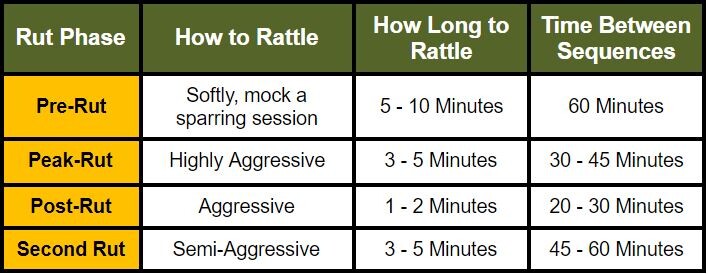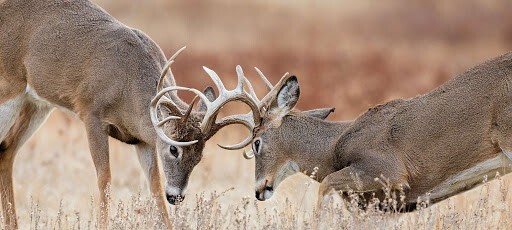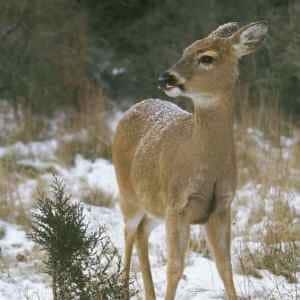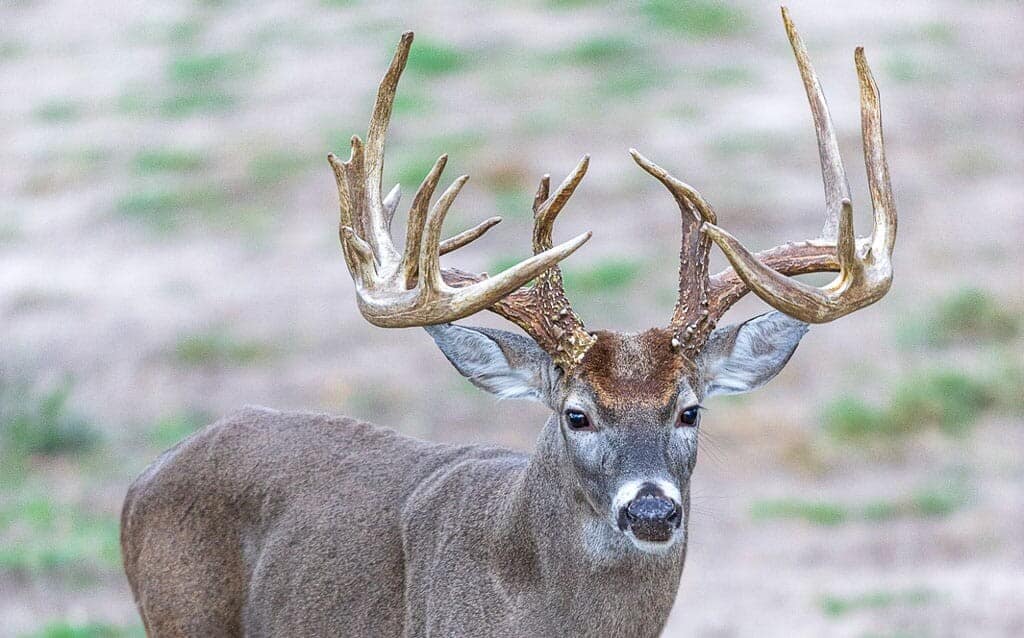Everyone has seen it on their favorite hunting shows, a guy starts rattling and then a giant buck almost immediately comes running his way. The funny thing is, it never seems to work that way when we do it on our own. While rattling is not magic, it can certainly bring in deer. Although, there are a few important things that go into rattling that you could be getting wrong. All we need to do is learn the basics of how to rattle for each of the rut phases. You may not think about it, but whitetails fight differently throughout the year. With some basic knowledge of the rut phases, we can take advantage of this and start to see some results with rattling.
Before we dive into the specifics of the rut phases, here is an overview:

Rattle Frequency Depending on the Rut Phase
When you think about rattling, it seems pretty simple. That’s because it is. Although, just like most things in the hunting world, people love to make it as complicated as possible. Here we are going to cut through the noise and focus on the most important aspect of rattling, timing with the rut phases. Then we will go over some basics and key tips to rattling overall.
Pre Rut
During the pre-rut, bucks have just shed their velvet and are establishing their hierarchy. So while they may be breaking up from their bachelor groups and intimidating smaller bucks, there are not that many fights going on, they are mostly just sparring. There are a few fights, but fighting will ramp up later in the rut.
With that being said, they will still respond to rattling. Start rattling around an hour after daylight on a clear day. You also want to make sure you are rattling softly. You can really just tickle the tips of your antlers together for 20 seconds or so and then stop for a few seconds. This sounds like a small sparring session. You can carry on like this for 5 or 10 minutes. Then you should wait about an hour before trying again. Odds are you are going to get a lot of younger bucks responding to early-season rattling, but there is always a chance a bruiser can come through.

Peak Rut
When the rut goes into full swing in your area, then rattling gets really fun. During the peak rut, it is time to get as aggressive as you want to with your rattling sequence. Bucks are running around everywhere, trying to lockdown does and they are not afraid to fight anything that gets in their way. Coming in and stealing a doe from the tired victor of a fight could be an easy score for them.
So during this period, you want to clash your antlers together very loudly, but you also need to make the frequency at which you hit them together sounds realistic. I suggest checking out some videos of whitetail fights online. You should study how often they actually clash together. If you just bang them together as fast as possible, you are more likely to run the deer off than draw them in.
During the full rut, you want to start off rattling about 30 minutes after daylight. Then you can aggressively rattle for about 3-5 minutes. I do not like to blindly rattle for much longer than that, and most real fights last about that long anyway. Afterward, you need to wait at least 30-45 minutes before you start again.

Post Rut
You may not think it at first, but the post-rut can be a great time to rattle in mature bucks. Most of the does have been in and out of heat, but bucks are still aggressive and are looking for the late-blooming does. Bucks know the rut is winding down and they are running out of time to find a doe. So it is not too far fetched to catch the ear of a cruising buck just a few hundred yards away and bring him in. During the post-rut, we are more likely to see more mature bucks responding to rattling. They are going to be the most aggressive, in hopes of locking down the last receptive doe.
During the post-rut, you want to rattle aggressively for about 1-2 minutes. Then you want to wait about 20-30 minutes before you start again. In the post-rut, it is vital to keep it short but you can also rattle more frequently. Most bucks are going to be fairly worn out from the rut, so you can bet that fights are not going to last as long. Plus with rattling being more attractive at this point in the rut, you do not want to be stuck with those antlers in your hands when a buck comes by. Just because you only rattle for a minute, bucks could be coming your way because of it a while later.
Second Rut

The second rut is an odd time of year that is not always noticeable. Typically the second rut is a period after the peak rut with the post-rut in-between. The second rut is when does that did not go into estrus in November begin to go into estrus. This typically happens for about a week in mid-December. Bucks are going to be cruising for these does that have just come into estrus, but they will not be running around like the peak-rut. Their movements will be conservative, but they will be moving more than usual.
During the second rut, you are going to have to be loud about your rattling. Most bucks are worn out, so bucks, in general, are not going to be as aggressive as they have been. With that being said, the mature bucks may be more active than the younger bucks that have been getting pushed around during the fall season. During this time, you can rattle for about 5 minutes; you want to be loud, but tone the aggressiveness back a notch. Then, we need to wait for about 45 minutes to an hour before you go at it again. Rattling can work during the second rut, but you may be better off using other calls or strategies during this period.
How to Rattle in Big Bucks | The Keys to Rattling
So now that you know how long and how often to rattle during each phase of the rut, let’s dive into how to be good at rattling.
The most important thing is keeping it realistic. You need to rattle slowly. Clashing antlers together as fast as you can sounds nothing like a real whitetail fight. You need to hit them, then wait for a second or two, and do it again. Repeat this process over and over, hitting the antlers a little differently each time. It will not take long before you find a rhythm.
Next, knowing where to rattle can be a game-changer. Some places on your property are more prone to fights than others. For example, you are more likely to have a fight where there are a lot of rut sign like scrapes and rubs, versus a place where you do not have any sign at all. So if you plan on rattling a lot, I suggest you set up close to somewhere that has a scrape or rub line close by instead of somewhere like a food plot. Although make sure you are not sitting on top of it.

Next, we can think about the time of day you rattle. Now of course you can rattle all day long if you like. As long as you wait a while between sequences you will be fine. Although, when will rattling be most effective? Well, it is most effective when the deer are moving the most. Typically that is during the mornings and evenings, but depending on the weather that could change a bit. Check out my post here about when whitetails are most active.
Quick Tip: You also need to know when not to rattle. When you get a buck within sight, be careful with your rattling. You need to stay hidden, and if they hear rattling close by they will expect to see some action, not you in a tree.
What to Use for Rattling
Lastly, we need to make sure we have the right tools for the trade. You can rattle with a bunch of different tools. The most obvious is a set of real antlers. You can use shed antlers or a rack from one of your past deer. I recommend using a smaller 8 point buck rack if you go this route. This way the rack is big enough to make a lot of noise, but you are not carrying around a large rack. You probably want those on the wall anyway.
They also make a lot of synthetic calls you can use to imitate a rattle. One of my favorites is the Bone Collector Bag-O-Bones. It is a rattle bag that is just easy to throw in your pack and easy to use. If I can save space and still draw in bucks, I love it.
You can also use synthetic horn systems like the Black Rack. They sound just like real antlers but are a little easier to carry around, and you do not have to sacrifice your own set for rattling. You can also use the Knight & Hale Pack Rack. It is a small system that you can use easily without having to move too much. Plus it goes easily in your pack. These all work great, it just depends on your personal preference.
Conclusion
During the pre-rut we need to rattle softly, we are doing our best to imitate a sparring session. During the peak-rut, it’s all fair game. We can comfortably rattle as aggressively as we like, although I would not call all day long. You need to wait around 30-45 minutes between sequences. During the post-rut, things are starting to wind down, but bucks are still going to respond to rattles. Then things ramp up again in the secondary rut, where you could have some success with moderately aggressive rattling.
Now that you have seen how to use a rattle call throughout the rut, you should be able to bring a buck in this season. Rattling is a lot of fun but it takes a bit of practice. Just keep trying, and eventually, you will be able to add it to your tool belt. The more tools we have the better hunters we become!
Sister Post | How Often Should You Grunt During the Rut?
A sister post is another post that I have written that follows along with the same topic as the one you just read. I think that following this post, my post about how often you should grunt during the rut will provide a lot of value and may teach you even more about deer and deer grunting.
It may come as a surprise to some, but whitetail deer are actually fairly vocal creatures and make many different sounds, especially during the rut. Actually, the grunt call is one of the best tools we have against a buck during the rut…Keep Reading
Grunt Frequency Depending On The Rut
Just like a lot of things with whitetail, the frequency at which you should blindly use a grunt call depends on the time of year. During the pre rut…Keep Reading
Blind Grunt Calling
You use a grunt call in two main situations. When you see a buck and.. Keep Reading
